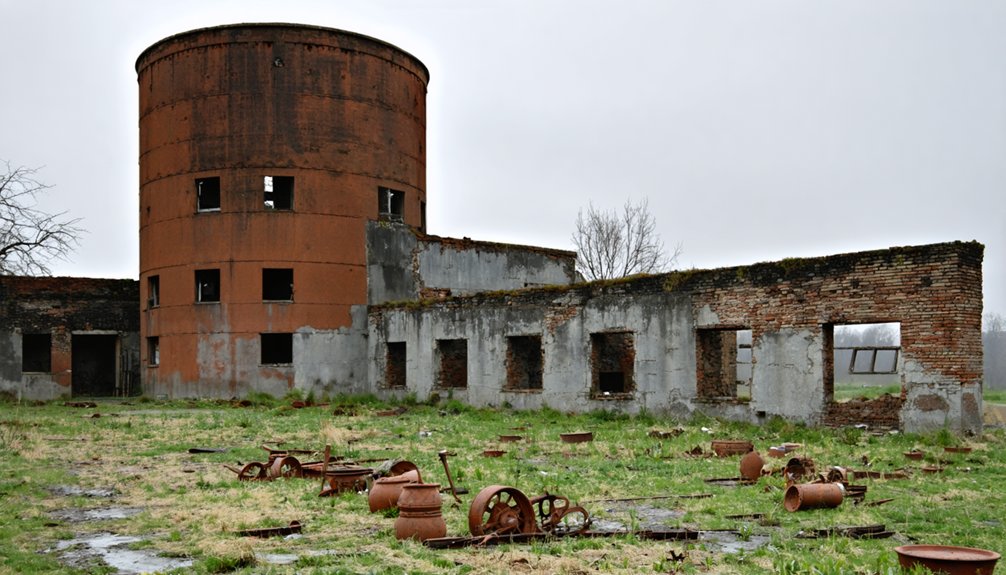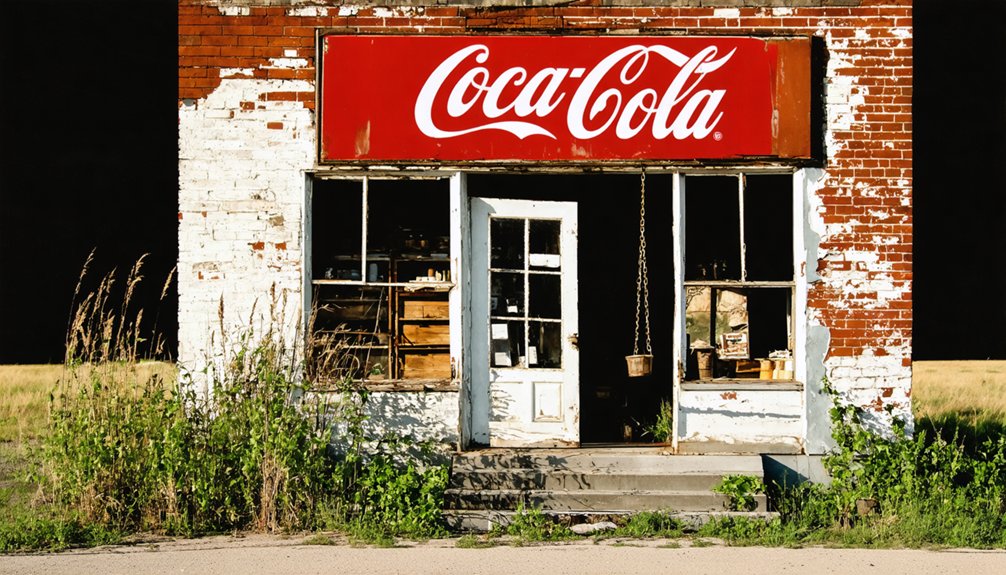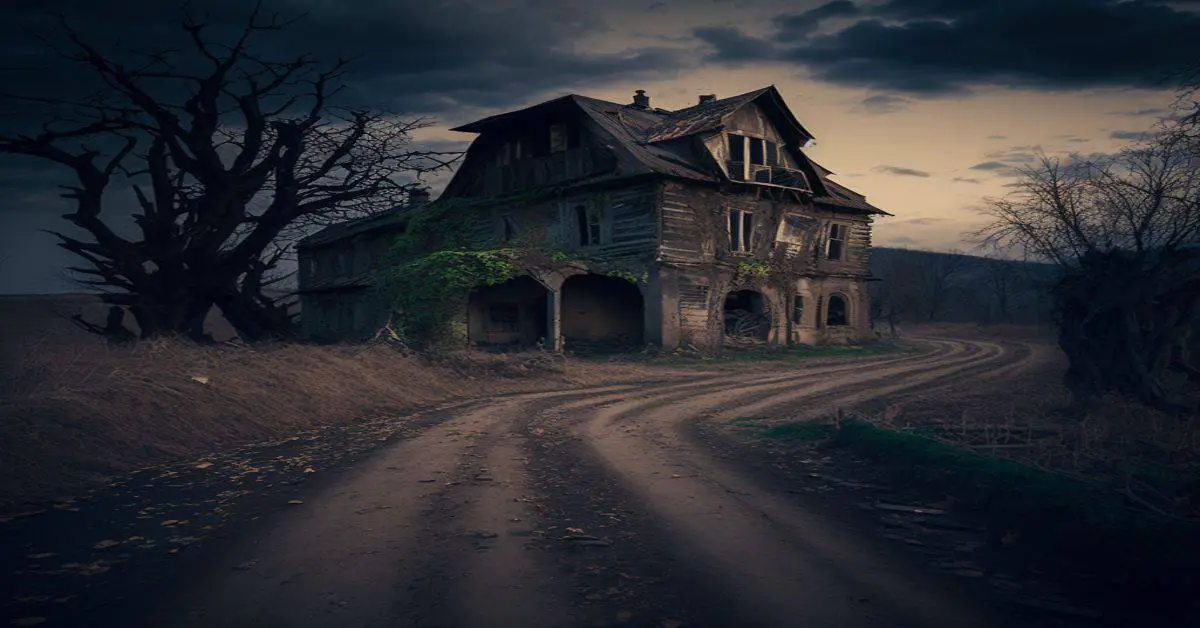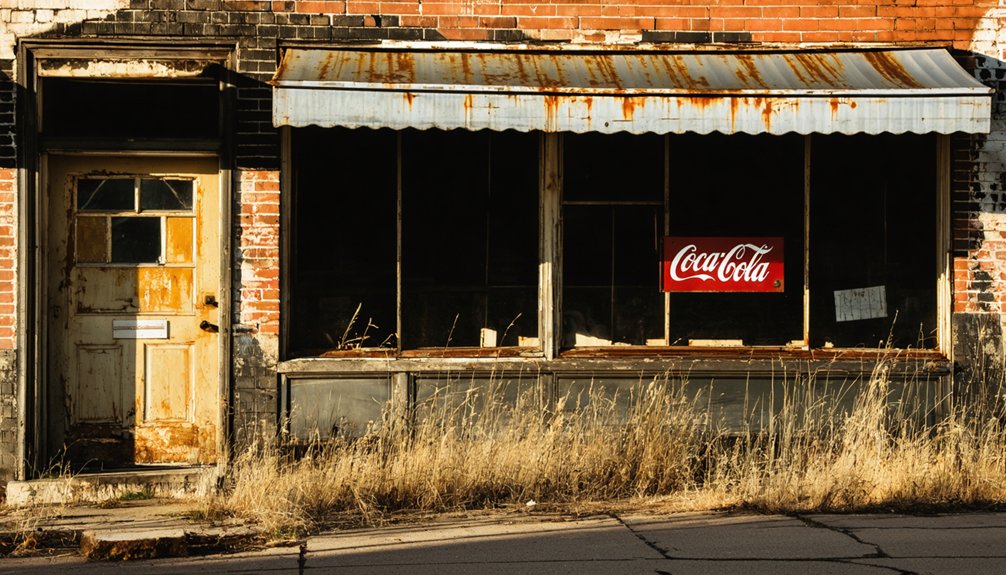You’ll find Jugtown’s ghost town remnants near the Kankakee and Des Plaines rivers, where rich clay deposits sparked Illinois’ first major pottery industry in the 1820s. The Goose Lake Stoneware Manufactory, established in 1856 with a $12,000 investment, marked the town’s industrial peak before financial troubles and changing markets led to its decline. Today, preserved kiln sites and archaeological treasures within Goose Lake Prairie State Natural Area tell a fascinating story of innovation and persistence.
Key Takeaways
- Jugtown emerged in the 1820s as a pottery settlement after discovering rich clay deposits near the Kankakee and Des Plaines rivers.
- The Goose Lake Stoneware Manufactory, established in 1856, marked the town’s industrial peak before financial troubles led to closure in 1866.
- Economic pressures, poor drainage, and competition from glass containers contributed to the settlement’s eventual abandonment as a pottery center.
- Archaeological evidence, including kiln sites and ceramic pieces, remains preserved within the Goose Lake Prairie State Natural Area.
- The town’s remnants are listed on the National Register of Historic Places, preserving its legacy as an early Illinois industrial settlement.
The Rise of a Pottery Powerhouse
While the exact founding date remains unclear, Jugtown’s pottery industry emerged in the 1820s when settlers discovered the area’s rich clay deposits.
You’ll find that early production focused on practical earthenware that frontier families desperately needed. Local pottery techniques developed under master craftsmen who combined skilled artisans with general laborers in traditional workshops. Like Jugtown Pottery in North Carolina, the artisans perfected their craft using salt-glazed wares.
Skilled craftsmen led mixed teams of artisans and laborers to create the essential earthenware that pioneer households required for daily life.
Located six miles east of Morris, Illinois, the settlement quickly became a hub for clay excavation and pottery production.
The industry’s real turning point came in 1856 with the establishment of the Goose Lake Stoneware Manufactory and Tile Works.
This ambitious venture represented one of Illinois’ first attempts at industrial-scale pottery production. The community impact was significant, creating jobs and economic opportunities.
The facility produced both stoneware containers for food storage and innovative drainage tiles, using steam-powered equipment and mechanical dies for more efficient production.
Clay Resources and Early Settlement
You’ll find the origins of Jugtown’s pottery industry in the rich clay deposits left behind by the ancient Goose Lake, a glacial floodplain that once covered the area.
During the 1820s, early settlers discovered these valuable clay beds near the confluence of the Kankakake and Des Plaines rivers, recognizing their exceptional quality for earthenware production.
The natural clay resources, which could reach depths of 200 feet and consisted of fine-grained sediments ideal for pottery, attracted skilled artisans who’d establish the community’s first small-scale clay works.
Clay Discovery Period
During the early 1820s, settlers in present-day Grundy County, Illinois, discovered rich clay deposits that would shape the region’s future.
You’ll find the Goose Lake area was particularly blessed with exceptional clay geology, drawing both farmers and skilled European potters westward to this untamed frontier. While no formal town existed yet, these pioneering settlers quickly recognized the clay’s potential and began extracting it for their immediate needs. Much like the early orange earthenware traditions of North Carolina, local potters developed their own distinctive utilitarian style.
The early pottery techniques were modest but practical – settlers hand-formed essential items like jars, jugs, and roofing tiles, firing them in temporary kilns. By 1856, Charles Walker and White would establish a major pottery operation in the area.
They weren’t producing for commercial markets yet; instead, they focused on creating necessary items for frontier life. This resourceful community grew organically around the clay deposits, establishing the foundation for what would later become a significant pottery-producing region.
Natural Resource Utilization
The presence of rich clay deposits in Grundy County sparked an era of intensive natural resource development in the 1850s.
You’ll find that Jugtown’s transformation began when William White and Charles Walker established the Goose Lake Stoneware Manufactory and Tile Works in 1856, turning the area’s abundant clay into valuable pottery and tiles.
While early settlers recognized the potential for clay conservation and pottery education, they faced significant challenges.
The region’s poor drainage made farming difficult, leading them to focus on clay extraction and industrial development.
Though the pottery enterprise ultimately failed in 1866, it left an indelible mark on the landscape.
Today, you can explore the archaeological remains of the Pottery Works and Tile Works sites, which stand as evidence to this brief but significant period of industrial innovation.
Similar to St. Louis’s Cheltenham district, the area attracted immigrant laborers who formed tight-knit communities around the clay works.
Settlers in the 1820s were among the first to recognize and exploit the area’s clay-rich sediment for earthenware production.
White and Walker’s Industrial Vision
When William White arrived in Illinois in October 1855, he brought with him an ambitious vision to transform the clay-rich lands near Goose Lake Prairie into a major industrial pottery operation.
Similar to White County’s thriving agricultural production, the area had abundant natural resources to support manufacturing growth. You’ll find that his partnership with Chicago financier Charles Walker, forming “White and Company,” represented one of the area’s boldest industrial partnerships of the era. They invested $12,000 to purchase hundreds of acres near Jugtown and install industrial equipment and kilns for producing stoneware and drain tiles.
Their business launched during a period when coal mining was becoming increasingly important to central Illinois’ economy. Despite their forward-thinking approach to mechanized pottery production, they faced mounting financial challenges.
The remote location’s poor access to the Illinois and Michigan Canal, combined with the devastating Panic of 1857, strained their operations. These pressures ultimately led to creditor lawsuits and the partnership’s dissolution in 1866.
Daily Life in a Pottery Town
Beyond White and Walker’s industrial ambitions, Jugtown’s daily rhythms centered on the steady work of pottery production that shaped both economic and social life in this close-knit community.
You’d find potters working at their wheels in simple structures with dirt floors, crafting utilitarian wares from local Goose Lake clay. Community traditions flourished as knowledge passed through generations, while artisan collaborations with visiting artists like the Busbees brought fresh creative perspectives. Public demonstrations helped elevate the visibility of local potters and their craft. The advent of glass containers and refrigeration gradually reduced the demand for traditional stoneware pieces.
Life revolved around the kilns’ firing schedules, with salt-glazing and cobalt blue slip decorations adding distinctive touches to the functional pieces.
In these modest homes near the pottery works, families lived simply, their livelihoods tied to the seasonal cycles of clay processing and the steady demand for stoneware across the region.
The Decline of Jugtown’s Industry

Despite early promise and rich clay deposits, Jugtown’s industrial pottery venture met an abrupt end in 1866 when financial troubles forced its backers to cease operations.
Financial woes brought Jugtown’s pottery dreams crashing down in 1866, despite abundant local clay and initial optimism from investors.
You’ll find several key economic challenges and competition factors that sealed Jugtown’s fate:
- The rise of glass containers cut deeply into traditional pottery markets, while cheaper imported wares flooded the region.
- Jugtown’s remote location, six miles from Morris, hampered distribution and made attracting skilled labor difficult.
- The operation couldn’t match the efficiency of larger competitors, struggling with dated kiln technology and limited production capacity.
- Changes to Goose Lake’s environment affected local resources, while the death of Charles Walker left the enterprise without key leadership.
The once-promising pottery town couldn’t survive the industrial consolidation sweeping through 19th century Illinois, becoming another casualty of changing markets.
Archaeological Discoveries and Preservation
You’ll find significant archaeological treasures at Jugtown’s Pottery Works and Tile Works sites, both now listed on the National Register of Historic Places for their exceptional historical value.
These sites have revealed extensive evidence of 19th-century industrial pottery production, including remnants of kilns and ceramic pieces that showcase the area’s once-thriving clay industry.
The preservation of these sites within the Goose Lake Prairie State Natural Area guarantees that Jugtown’s rich industrial heritage and its valuable clay deposits remain protected for future study and appreciation.
Unearthed Pottery Work Sites
Archaeological excavations have revealed two significant production sites within Jugtown: the Pottery Works Site and the Tile Works Site, both situated near Pine Bluff Road in Grundy County’s Goose Lake Prairie State Natural Area.
At these sites, you’ll find evidence of America’s industrial transformation through pottery techniques and worker conditions from 1856 to 1866.
The archaeological record shows:
- Hand-thrown stoneware production using traditional pottery wheels
- Early mass production experiments with molded bowls and decorative jar lids
- Steam-powered machinery for extruding clay into drainage tiles
- Living quarters that reveal the shift from skilled artisans to unskilled laborers
The sites’ artifacts demonstrate the evolution from frontier craftsmanship to industrial-scale manufacturing, making Jugtown one of Illinois’ earliest attempts at modernized pottery production.
Preserving Historical Clay Deposits
The rich clay deposits that made Jugtown’s pottery production possible still lie beneath Goose Lake Prairie State Natural Area, preserved alongside the historic kiln sites and production areas.
You’ll find these distinctive clay beds, shaped by ancient alluvial processes, protected within the preserve’s boundaries, where they’ve remained largely untouched since the pottery works closed in 1866.
The historical significance of these deposits extends beyond their industrial past.
Today’s clay conservation efforts focus on maintaining the natural drainage patterns that originally made this area so appealing to William White and Charles Walker.
While you can’t extract clay here anymore, you can explore the archaeological sites where excavations have revealed the remnants of both hand-powered pottery wheels and steam-driven tile manufacturing equipment, telling the story of Illinois’ early ceramic industry.
Legacy in Illinois History

Despite its brief existence, Jugtown stands as a significant milestone in Illinois’ early industrial development, marking one of the state’s first attempts at large-scale pottery and tile production.
The industrial heritage of this frontier venture continues to intrigue historians and archaeologists studying early American manufacturing.
You’ll find Jugtown’s community legacy preserved through:
- Two archaeological sites within Goose Lake Prairie State Natural Area
- Historical records documenting the White-Walker pottery enterprise
- Physical remnants of clay extraction activities
- Educational programs highlighting early industrial ventures
Though the pottery works closed in 1866, Jugtown’s story exemplifies the pioneering spirit of Illinois’ industrial age.
Today, you can explore these historical sites, gaining insights into the challenges faced by early entrepreneurs who shaped the state’s manufacturing landscape.
Frequently Asked Questions
What Native American Tribes Originally Inhabited the Jugtown Area?
Despite losing 80% of their population by 1800, the Kickapoo were the last major native tribes to inhabit your area, following earlier Illiniwek presence until forced removal through the 1819 Treaty of Edwardsville.
Were Any Complete Pottery Pieces Recovered From the Jugtown Site?
You’ll find no complete pottery artifacts were recovered from the site – just fragments and shards that still hold historical significance for understanding 19th-century production methods and vessel forms.
How Did Residents Get Their Supplies Before the Pottery Industry?
Picture muddy paths through swampland – that’s how early settlers got their goods. You’d rely on hunting, fishing, basic farming, and limited trade with neighbors while making most necessities yourself.
What Happened to the Families Who Lived in Jugtown?
You’ll find that families scattered to nearby towns like Morris, seeking economic survival. Family legacies dispersed as community dynamics shifted, with most residents dismantling homes and following job opportunities elsewhere.
Are There Any Surviving Photographs of Jugtown’s Original Buildings?
You won’t find any surviving photographs of the original buildings – historical preservation efforts came too late, and architectural analysis relies solely on archaeological evidence rather than photographic documentation.
References
- https://drloihjournal.blogspot.com/2022/09/lost-towns-of-illinois-jugtown-illinois.html
- https://www.youtube.com/watch?v=gM3ZIgtFzBk
- https://www.heraldtimesonline.com/story/lifestyle/home-garden/2021/01/15/some-illinois-ghost-towns/43846097/
- https://podcasts.apple.com/us/podcast/midwest-ghost-town/id1726063962
- https://drloihjournal.blogspot.com/p/lost-towns-of-illinois-series.html
- https://northwestchicagoland.northwestquarterly.com/2023/09/27/ghost-towns-of-the-old-northwest/
- https://en.wikipedia.org/wiki/List_of_ghost_towns_in_Illinois
- https://www.jugtownware.com/history
- https://dnr.illinois.gov/naturalresources/cultural/jugtownp2.html
- https://thisdayinpotteryhistory.wordpress.com/tag/jugtown/



